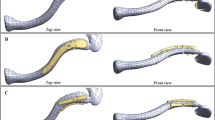Abstract
Purpose
A clavicle hook plate is a simple and effective method for treating acromioclavicular dislocation and distal clavicle fractures. However, subacromial osteolysis and peri-implant fractures are complicated for surgeons to manage. This study uses finite element analysis (FEA) to investigate the post-implantation biomechanics of clavicle hook plates with different hook angles.
Methods
This FEA study constructed a model with a clavicle, acromion, clavicle hook plate, and screws to simulate the implantation of clavicle hook plates at different hook angles (90°, 95°, 100°, 105°, and 110°) for treating acromioclavicular joint dislocations. This study investigated the biomechanics of the acromion, clavicle, hook plate, and screws.
Results
A smaller hook angle increases the stress on the middle third of the clavicle. A larger hook angle increases the force exerted by the clavicle hook plate on the acromion. The screw at the most medial position on the plate generated the highest stress. The highest stress on the implanted clavicle hook plate was on the turning corner of the hook.
Conclusions
A clavicle hook plate with different hook angles may induce different biomechanical behaviors in the clavicle and acromion. Orthopedic surgeons must select a suitable clavicle hook plate based on the anatomical structure of each patient.





Similar content being viewed by others
References
Di Francesco A, Zoccali C, Colafarina O, Pizzoferrato R, Flamini S (2012) The use of hook plate in type III and V acromio-clavicular Rockwood dislocations: clinical and radiological midterm results and MRI evaluation in 42 patients. Injury 43(2):147–152. doi:10.1016/j.injury.2011.04.002
Tiren D, van Bemmel AJ, Swank DJ, van der Linden FM (2012) Hook plate fixation of acute displaced lateral clavicle fractures: mid-term results and a brief literature overview. J Orthop Surg Res 7:2–9. doi:10.1186/1749-799X-7-2
Johansen JA, Grutter PW, McFarland EG, Petersen SA (2011) Acromioclavicular joint injuries: indications for treatment and treatment options. J Shoulder Elbow Surg 20:S70–S82. doi:10.1016/j.jse.2010.10.030
Kim YS, Yoo YS, Jang SW, Nair AV, Jin H, Song HS (2015) In vivo analysis of acromioclavicular joint motion after hook plate fixation using three-dimensional computed tomography. J Shoulder Elbow Surg 24(7):1106–1111. doi:10.1016/j.jse.2014.12.012
Arirachakaran A, Boonard M, Piyapittayanun P, Phiphobmongkol V, Chaijenkij K, Kongtharvonskul J (2016) Comparison of surgical outcomes between fixation with hook plate and loop suspensory fixation for acute unstable acromioclavicular joint dislocation: a systematic review and meta-analysis. Eur J Orthop Surg Traumatol 26(6):565–574. doi:10.1007/s00590-016-1797-4
Hoffler CE, Karas SG (2010) Transacromial erosion of a locked subacromial hook plate: case report and review of literature. J Shoulder Elbow Surg 19(3):e12–e15. doi:10.1016/j.jse.2009.10.019
Chiang CL, Yang SW, Tsai MY, Kuen-Huang Chen C (2010) Acromion osteolysis and fracture after hook plate fixation for acromioclavicular joint dislocation: a case report. J Shoulder Elbow Surg 19(4):e13–e15. doi:10.1016/j.jse.2009.12.005
Lin HY, Wong PK, Ho WP, Chuang TY, Liao YS, Wong CC (2014) Clavicular hook plate may induce subacromial shoulder impingement and rotator cuff lesion—dynamic sonographic evaluation. J Orthop Surg Res 9:6. doi:10.1186/1749-799X-9-6
Charity RM, Haidar SG, Ghosh S, Tillu AB (2006) Fixation failure of the clavicular hook plate: a report of three cases. J Orthop Surg (Hong Kong) 14(3):333–335
Ding M, Ni J, Hu J, Song D (2011) Rare complication of clavicular hook plate: clavicle fracture at the medial end of the plate. J Shoulder Elbow Surg 20(7):e18–e20. doi:10.1016/j.jse.2011.06.005
ElMaraghy AW, Devereaux MW, Ravichandiran K, Agur AM (2010) Subacromial morphometric assessment of the clavicle hook plate. Injury 41(6):613–619. doi:10.1016/j.injury.2009.12.012
Deng Z, Cai L, Ping A, Ai Q, Wang Y (2014) Anatomical research on the subacromial interval following implantation of clavicle hook plates. Int J Sports Med 35(10):857–862. doi:10.1055/s-0034-1367050
Cronskar M, Rasmussen J, Tinnsten M (2015) Combined finite element and multibody musculoskeletal investigation of a fractured clavicle with reconstruction plate. Comput Methods Biomech Biomed Eng 18(7):740–748. doi:10.1080/10255842.2013.845175
Lee CH, Shih CM, Huang KC, Chen KH, Hung LK, Su KC (2016) Biomechanical analysis of implanted clavicle hook plates with different implant depths and materials in the acromioclavicular joint: a finite element analysis study. Artif Organs. doi:10.1111/aor.12679
Shih CM, Huang KC, Pan CC, Lee CH, Su KC (2015) Biomechanical analysis of acromioclavicular joint dislocation treated with clavicle hook plates in different lengths. Int Orthop 39(11):2239–2244. doi:10.1007/s00264-015-2890-8
Lee HH (2014) Finite element simulations with ANSYS workbench 15. Chuan Hwa Book Co., Taiwan
Su KC, Chuang SF, Ng EYK, Chang CH (2014) Evaluation of dentinal fluid flow behaviours: a fluid–structure interaction simulation. Comput Methods Biomech Biomed Eng 17(15):1716–1726. doi:10.1080/10255842.2013.765410
Callister WD, Rethwisch DG (2007) Materials science and engineering: an introduction. Wiley, New York
Acknowledgements
The authors acknowledge the United States National Library of Medicine (NLM) and the Visible Human Project as the source of the image data used to create the finite element analysis model in this study. The first two authors have contributed equally to this work.
Author information
Authors and Affiliations
Corresponding author
Ethics declarations
Conflict of Interest
The authors declare that they have no conflict of interest.
Funding
There is no funding source.
Ethical approval
This article does not contain any studies with human participants or animals performed by any of the authors.
Informed consent
Informed consent was obtained from all individual participants included in the study.
Additional information
Li-Kun Hung and Kuo‐Chih Su contributed equally to this work.
Rights and permissions
About this article
Cite this article
Hung, LK., Su, K., Lu, WH. et al. Biomechanical analysis of clavicle hook plate implantation with different hook angles in the acromioclavicular joint. International Orthopaedics (SICOT) 41, 1663–1669 (2017). https://doi.org/10.1007/s00264-016-3384-z
Received:
Accepted:
Published:
Issue Date:
DOI: https://doi.org/10.1007/s00264-016-3384-z




